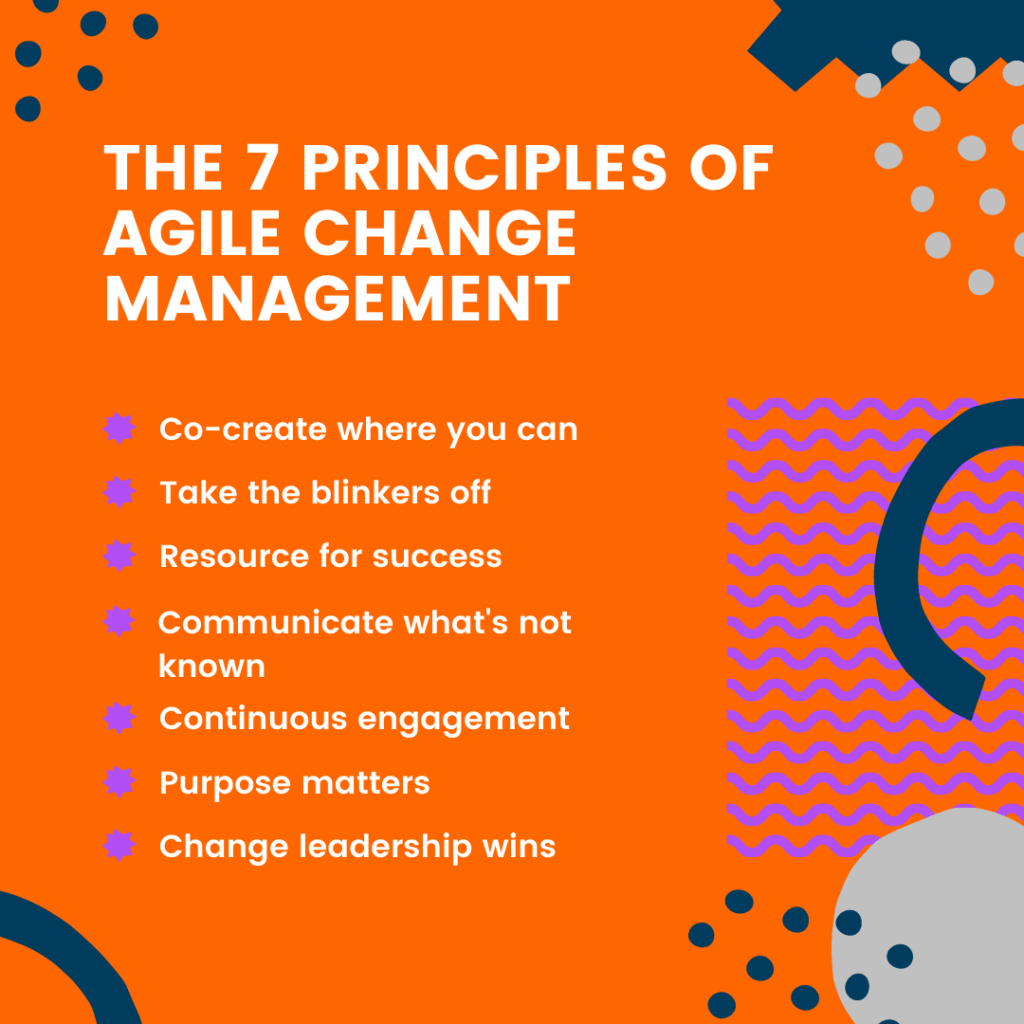“If you want to understand something deeply, you must start with principles.”
— Richard Feynman
There’s a reason we keep coming back to principles when the work gets messy.
In change management, where emotions run high, uncertainty is ever-present, and the path forward is rarely linear, principles act as our compass.
They help us navigate complexity and avoid getting lost in the noise of endless frameworks, tools, and checklists.
Recently, someone asked me: “What do you think are the core principles of good change management?”
It got me thinking.
I’ve had the privilege of working with many organisations that do change well, where the experience of change felt meaningful, manageable, and even energising.
Reflecting on those moments, these seven principles rose to the surface.
I’d love to hear yours. What would you add?
Table of Contents

1. Co-create wherever you can
People support what they help to create.
Involving your stakeholders, especially those most affected by the change, in designing both what the change is and how it will be rolled out is a proven way to reduce resistance.
But it’s not just about buy-in.
Co-creation often leads to smarter, more workable solutions.
Invite feedback early.
Use workshops, prototypes, or even informal check-ins.
When people see their fingerprints on the final product, ownership skyrockets.
2. Take the blinkers off
No change happens in isolation.
It’s tempting to stay in your lane, focus on your project, and tune out everything else.
But ignoring the broader landscape can undermine your change.
Competing initiatives, seasonal pressures, policy changes—these all shape the success of your work.
Make time to speak with other leaders.
Understand what else is happening across the organisation.
Map out a “change radar” to anticipate what’s dropping when.
This allows you to clear the runway or ride the momentum.
Note: A change radar is a simple planning tool that gives visibility over all upcoming changes across an organisation. It maps the timing, scale, and impact of change initiatives—so teams can see what’s landing when.
Think of it like air traffic control for change. It helps you spot where multiple projects might collide, where there’s too much happening at once, or where momentum from one change could support another.
Most teams build a radar as a calendar or visual timeline. It doesn’t need to be complex. What matters is that it shows enough to help you coordinate, adjust timing, and reduce overload.

3. Resource for success
Change isn’t a side hustle.
Expecting teams to deliver business-as-usual and implement change, with no additional support, is a fast track to burnout and half-baked outcomes.
During change, multitasking compromises everything: quality, morale, and the change itself.
Invest in backfill where needed. Bring in skilled change practitioners.
Ensure you’ve got capacity—not just capability—on your side.
Under-resourcing is one of the most common and preventable reasons change fails.
4. Communicate what’s known, what’s not, and what’s next
Don’t wait for perfect information. It won’t come.
In the absence of communication, people will fill in the blanks with rumour, fear, or assumptions.
Our brains crave certainty, and when we’re left in limbo, we experience emotional discomfort and stress.
Be honest. Tell people what you know. Acknowledge what you don’t. Let them know when they can expect updates.
A little transparency goes a long way in building trust—and calming nerves.
5. Engagement wins every time
You don’t need a resistance strategy. You need an engagement strategy.
Change resistance is often just a symptom of low engagement.
People disengage when they don’t feel heard, when they don’t understand the why, or when they feel something is being done to them rather than with them.
Keep the engagement ongoing, not one-off. Ask questions. Hold space for feedback. Loop back with answers. And most importantly, show you’ve listened.
6. Purpose matters
Purpose beats perks. Every time.
People are more likely to embrace change when they understand how it connects to something bigger, beyond the task, the tool, or the team.
When a change aligns with a clear and meaningful purpose, it resonates. It makes sense. It feels worth the effort.
If your change doesn’t align with the organisation’s core purpose or values, you’ve got a much harder road ahead.
Or worse, you’re heading in the wrong direction altogether.
7. Change leadership is critical
The fish rots from the head.
No matter how good your change plan is, it won’t land without visible and consistent leadership support.
Leaders need to champion the change, walk the talk, and model the behaviours they want to see.
People watch what leaders do more than what they say.
A visibly committed leadership team can carry a flawed change effort.
But the best plan in the world won’t survive passive or misaligned leadership.
How to Introduce These Principles to Your Team
Principles only make an impact when they’re lived, not laminated. Sharing them with your team is a good start, but embedding them takes intention.
Start by making them visible.
Print the principles and place them where your team gathers, whether that’s meeting rooms, digital boards, or planning walls. Keep them in sight to keep them in mind.
Use team check-ins to bring them to life.
Ask simple, open questions:
- Which principle feels most relevant this week?
- Where did we see one of these in action?
- Are we working with or against these right now?
Host a short session to explore each principle.
Let your team talk about what it means to them. Keep it informal. The goal isn’t to align on one definition, but to invite reflection.
Link the principles to real work.
When planning a new project or reviewing a change, bring the principles into the conversation. For example:
- Have we co-created the approach with the people most affected?
- Are we resourced properly, or are we hoping for the best?
Avoid making it a box-ticking exercise.
Principles lose power when they’re treated like a checklist. Instead, use them as prompts for better decisions and honest conversations.
Over time, your team won’t need to refer to a list. They’ll start working in a way that reflects the principles because they’ve made them their own.
What Makes a Principle Different from a Framework or Tool?
Principles guide how we think. Frameworks and tools guide what we do.
- A principle is a belief. It shapes decisions and behaviour across any context.
- A framework is a structure. It organises actions into a process or approach.
- A tool is a method. It helps you carry out a specific task.
For example:
- “Co-create wherever you can” is a principle.
- A stakeholder engagement plan is a framework.
- A feedback form is a tool.
Each serves a purpose, but principles lead. They help you choose the right framework. They help you use tools in the right way. When pressure builds or ambiguity rises, principles keep you anchored.
Without principles, even the best frameworks feel hollow. Tools become mechanical. People follow steps without meaning.
When you lead with principles, the work feels aligned—because it is.
Final Thought: Principles First, Then Practice
These principles aren’t rules. They’re reminders. Anchors. Starting points for reflection when you’re planning your next change, or wondering why one didn’t land.
If these resonate with you, and you’re curious about how to embed them into more adaptive, iterative approaches to change, you might want to explore agile ways of working.
Many of these principles are shared by agile change practices and can be brought to life through tools like change canvases, roadmaps, experiments, and continuous feedback loops.
But whether you’re working in a traditional, hybrid, or agile environment—the principles still apply.
The question is: Are you working with them, or against them?
Want to move beyond theory and apply these principles with confidence?
The Agile Change Manager Certificate Program is designed for professionals who lead change and want to do it better, without getting stuck in frameworks or jargon.
You’ll learn how to co-create change strategies, build engagement, respond to shifting priorities, and lead with purpose, using tools that work in real environments, not just ideal ones.
This course gives you practical methods, expert guidance, and space to reflect, so you can lead change that lands, sticks, and makes a difference.



